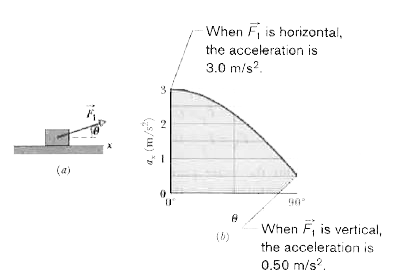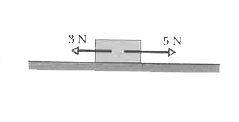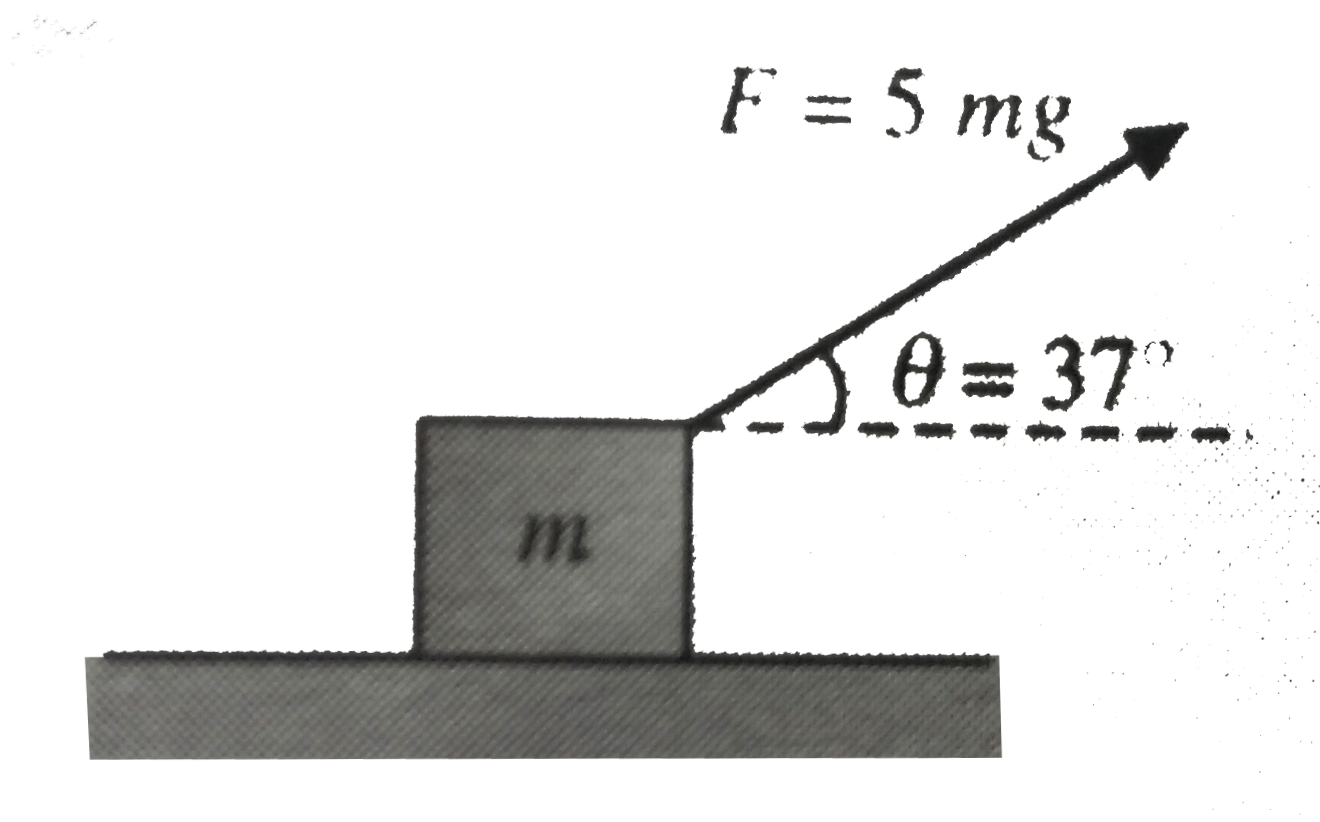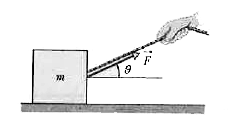Here is an example of where you must dig information out of a graph, not just read off a number. In Fig. 5-24a, two forces are applied to a 4.00 kg block on a frictionless floor, but only force →F1 is indicated. That force has a fixed magnitude but can be applied at an adjustable angle θ to the positive direction of the x axis. Force F2 is horizontal and fixed in both magnitude and angle. Figure 5-24b gives the horizontal acceleration ax of the block for any given value of θ from 0∘ to 90∘. What is the value of ax for θ=180∘ ?
(1) The horizontal acceleration ax depends on the net horizontal force Fnet, x, as given by Newton.s second law. (2) The net horizontal force is the sum of the horizontal components of forces →F1 and →F2.
Calculations: The x component of →F2 is F2 because the vector is horizontal. The x component of →F1 is F1cosθ. Using these expressions and a mass m of 4.00 kg, we can write Newton.s second law (→Fnet=m→a) for motion along the x axis as
F1cosθ+F2=4.00ax, (5−35)
From this equation we see thyat when angle θ=90∘,F1cosθ is zero and F2=4.00ax. From the graph we see that the corresponding acceleration is 0.50 m/s2. Thus, F2=2.00 N and →F2 must be in the positive direction of the x axis.
From Eq. 5-35, we find that when θ=0∘,
F1cos0∘+2.00=4.00ax. (5−36)
From the graph we see that the corresponding acceleration is 3.0 m/s2. From Eq. 5-36, we then find that F1=10 N.

Figure 5-24 (a) One of the two forces applied to a block is shown. Its angle θ can be varied. (b) The block.s acceleration component ax versus θ.
Substituting F1=10 N,F2=2.00 N, and θ=180∘ into
Eq. 5-35 leads to
ax=−2.00 m/s2
Topper's Solved these Questions
- BOOK - RESNICK AND HALLIDAYCHAPTER - FORCE AND MOTION - I EXERCISE - CHECKPOINT5videos
FORCE AND MOTION - I
- BOOK - RESNICK AND HALLIDAYCHAPTER - FORCE AND MOTION - I EXERCISE - PROBLEMS52videos
FORCE AND MOTION - I
- BOOK - RESNICK AND HALLIDAYCHAPTER - FLUIDSEXERCISE - PRACTICE QUESTIONS (Integer Type )5videos
FLUIDS
- BOOK - RESNICK AND HALLIDAYCHAPTER - FORCE AND MOTION-IIEXERCISE - PRACTICE QUESTIONS (Integer Type)1videos
FORCE AND MOTION-II
Similar Questions
The figure here shows two horizontal forces acting on a block on a frictionless floor. If a third horizontal force →F3 also acts on the block, what are the magnitude and direction of →F3 when the block is (a) stationary and (b) moving to the left with a constant speed of 5 m/s ?
 View Solution
View SolutionTwo blocks of mass m = 1 kg and M = 2 kg are in contact on a frictionless table. A horizontal force F(= 3N) is applied to m. The force of contact between the blocks, will be-
View Solution
Knowledge Check
- Question 1 - Select One
An object rests on a horizontal frictionless surface. A horizontal force of magnitude F is applied. This force produces an acceleration
Aonly if F is larger than the weight of the objectBonly while the object suddenly changes from rest to motionCalwaysDonly if the inertia of the object decreases. - Question 2 - Select One
A block of mass m is placed on a horizontla surface. If the block is pulled by applying a force of magnitude F=5mg at an angle θ=37∘, with horizontal as shown in fig. find the acceleration of the block at the given instant.
 A5√5gB3√5gC2√3gD2√5g
A5√5gB3√5gC2√3gD2√5g - Question 3 - Select One
Two forces F1 and F2 are applied simultaneously on a 2kg block resting on a frictionless horizontal ground. The forces vary with time according to graphs shown and cease to act after 8s. What maximum speed (inm/s) does the block acquire?
 A3B4C0D16
A3B4C0D16
A block of mass m is placed on a horizontla surface. If the block is pulled by applying a force of magnitude F=5mg at an angle θ=37∘, with horizontal as shown in fig. find the acceleration of the block at the given instant.
 View Solution
View SolutionTwo forces F1 and F2 are applied simultaneously on a 2kg block resting on a frictionless horizontal ground. The forces vary with time according to graphs shown and cease to act after 8s. What maximum speed (inm/s) does the block acquire?
 View Solution
View SolutionThe force magnitude F is slowly increased. What is its value just before the block is lifted (completely) off the floor ?
 View Solution
View SolutionTwo horizontal forces →F1 and →F2 act on a 4.0 kg disk that slides over frictionless ice, on which an xy coordinate system over frictionless ice, on which an xy coordinate system is laid out. Force →F1 is in the positive direction of the x axis and has a magnitude of 7.0 N. Force →F2 has a magnitude of 9.0 N. Figure 5-39 gives the x component vx of the velocity of the disk as a function of time t during the sliding. What is the angle between the constant directions of forces →F1 and →F2 ?
 View Solution
View SolutionIn Fig. 5-29, a block of mass m = 5.00 kg is pulled along a horizonttal frictionless floor by a cord that exerts a force of magnitude F = 12.0 at an angle θ=25.0∘.

Figure 5-29 A block is pulled along a horizontal floor.
(a) What is the magnitude of the block's acceleration?View Solution

